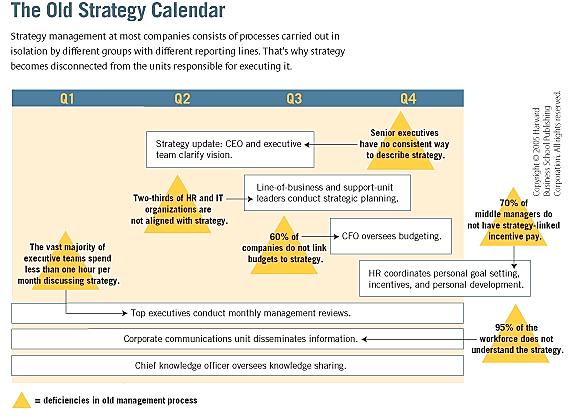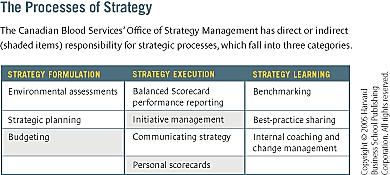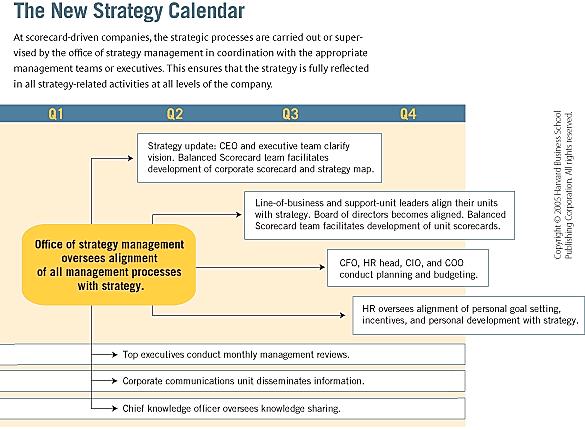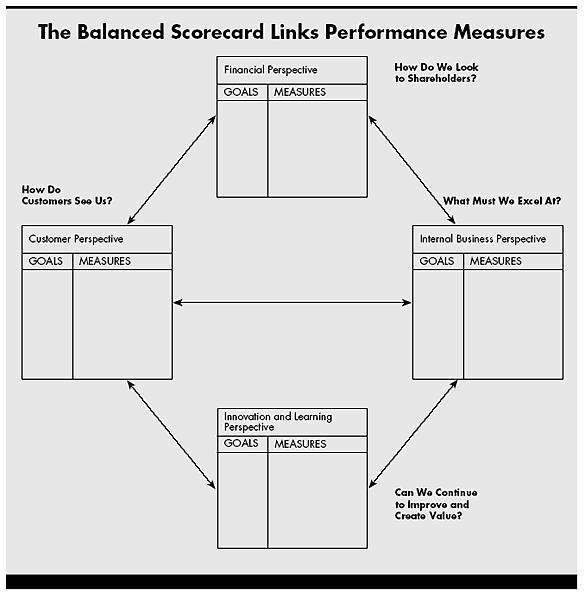Most companies have ambitious plans for growth. Few ever realize them. In their book Profit from the Core, Chris Zook and James Allen report that between 1988 and 1998, seven out of eight companies in a global sample of 1,854 large corporations failed to achieve profitable growth. That is, these companies were unable to deliver 5.5% annual real growth in revenues and earnings while earning their cost of capital (a rather modest hurdle). Yet 90% of the companies in the study had developed detailed strategic plans with much higher targets.
Why is there such a persistent gap between ambition and performance? The gap arises, we believe, from a disconnect in most companies between strategy formulation and strategy execution. Our research reveals that, on average, 95% of a company’s employees are unaware of, or do not understand, its strategy. If the employees who are closest to customers and who operate processes that create value are unaware of the strategy, they surely cannot help the organization implement it effectively.
It doesn’t have to be like this. For the past 15 years, we have studied companies that have achieved performance breakthroughs by adopting the Balanced Scorecard and its associated tools to help them better communicate strategy to their employees and to guide and monitor the execution of that strategy. (For background on the Balanced Scorecard, see our book The Strategy-Focused Organization, Harvard Business School Press, 2000.)
Some companies, of course, have achieved better and longer-lasting improvements than others. The organizations that have managed to sustain their strategy focus have typically established a new unit at the corporate level to oversee all strategy related activities, an office of strategy management (OSM), as we call it.
This might appear to be nothing more than a new name for the familiar strategic planning unit. But the two are quite different. The typical planning function facilitates the annual strategic planning process but takes little or no leadership role in seeing that the strategy gets executed. The companies we studied, however, recognize that effective strategy execution requires communicating corporate strategy; ensuring that enterprise-level plans are translated into the plans of the various units and departments; executing strategic initiatives to deliver on the grand plan; and aligning employees’ competency development plans, and their personal goals and incentives, with strategic objectives. What’s more, they recognize that the company’s strategy must be tested and adapted to stay abreast of the changing competition. The OSM becomes the central point for coordinating all these tasks. It does not do all the work, but it facilitates the processes so that strategy execution gets accomplished in an integrated fashion across the enterprise.
In the following pages, we will describe how the concept of the office of strategy management came into being and how it has helped companies align key management processes to strategy. Although the companies we have studied use the Balanced Scorecard as the framework for their strategy management systems, we believe that the lessons we draw are also applicable to companies that do not use the Balanced Scorecard.
Strategy Management: The New Support Function
The exhibit “The Old Strategy Calendar” depicts the strategy management schedule at a typical large company. The process starts about midway through the fiscal year, when the CEO and the executive team get together to clarify their strategic vision and update the strategy. Sometime afterward, similar processes take place at the business and functional units, led by unit heads and other senior executives. Toward the end of the third quarter, the finance function takes the baton, finalizing corporate and unit budgets. At the end of the year, the HR function conducts employees’ annual performance reviews and orchestrates the setting of professional goals and development programs. Throughout the year, meanwhile, different teams and units have engaged in performance reviews, corporate communication, and knowledge sharing.

The problem with this approach is that the activities are carried out largely in isolation and without guidance from the enterprise strategy. This partition of responsibilities creates the gulf between an organization’s strategy and its processes, systems, and people. Surveys that we conducted of HR and IT managers reveal that the strategies of fully 67% of those organizations are not aligned with business unit and corporate strategies; nor do HR and IT departmental plans support corporate or business-unit strategic initiatives. Budgeting is similarly disconnected: Some 60% of organizations do not link their financial budgets to strategic priorities. Incentives aren’t aligned, either: The compensation packages of 70% of middle managers and more than 90% of frontline employees have no link to the success or failure of strategy implementation. Periodic management meetings, corporate communication, and knowledge management are similarly not focused on strategy execution.
What can companies do to change this state of affairs? The experience of the Chrysler Group first suggested to us that the answer lies in bringing all strategy-related activities into a single functional unit. After a string of innovative successes in the early 1990s, Chrysler had hit a dry spell. Performance problems were exacerbated by an economic downturn, rising costs, and encroaching imports, and by 2000, the company was staring at a projected deficit of more than $5 billion for the coming year. At this point, the parent company, DaimlerChrysler, appointed a new CEO, Dieter Zetsche, who introduced the Balanced Scorecard as part of a major change in strategy. The project was spearheaded by Bill Russo, vice president of business strategy, whose unit worked with Chrysler’s executive team to translate the company’s new strategy into a Balanced Scorecard. Russo’s unit also served as trainer and consultant to help Chrysler’s business and support units create local scorecards that were aligned with corporate objectives and customized to local operations. Once the design phase had been completed and scorecards had been cascaded throughout the company, the strategy group maintained responsibility for the data collection and reporting processes for the scorecards.
Up to this point, Chrysler’s Balanced Scorecard project had followed a traditional course. Where Chrysler broke new ground was in the roles assumed by the strategy group. The group took the lead in preparing scorecard-related materials to communicate the strategy to the more than 90,000 employees. Russo began to brief Zetsche before each management meeting about issues that had been revealed through the scorecard reporting and that required management attention and action. In his capacity as a member of the executive team, Russo followed up after each meeting to make sure that the required items were communicated and acted upon. As a result of this proactive involvement in agenda setting and follow-up, the responsibilities of the business strategy function expanded to incorporate many new cross-enterprise strategy execution processes. Thus was born Chrysler’s Office of Strategy Management—a unit currently employing some 13 full-time people who not only manage the company’s strategy but also assist the business units in developing new products. Chrysler’s new approach to strategy execution appears to have paid off handsomely. In 2004, despite a weak domestic automobile market, Chrysler successfully launched a series of exciting new cars and generated $1.2 billion in earnings.
The U.S. Army’s Balanced Scorecard project produced an office of strategy management in much the same way. A central project team at the Pentagon headquarters, under the leadership of the Army chief of staff, developed the initial scorecard, which the Army called the Strategic Readiness System (SRS). The project team also selected the software to be used for scorecard reporting and established systems and processes so that the scorecard would be regularly populated with valid, timely data. In the next phase, the team helped to cascade scorecards to 13 major subcommands and subsequently to more than 300 subsidiary commands throughout the world. The centralized project team provided training, consulting, software, and online support for the dispersed project teams. The central team also reviewed the scorecards produced by local project teams to ensure that their goals were aligned with those articulated on the chief of staff’s scorecard.
The Army’s project team, like its counterpart at Chrysler, soon took on more than the traditional roles of scorecard custodian and consultant. It established and took ownership of a strategy communication program. The Army team created a Web site that was accessible from around the world in both classified and unclassified versions, developed an online portal and library containing information about the SRS, wrote articles about the initiative, published a bimonthly newsletter, conducted an annual conference, led periodic conference calls with SRS leaders at each command level, and conducted scorecard training, both in person and on the Web. This extensive communication process was critical for educating soldiers and civilian employees and gaining their support for the new strategy. And the Army project team, much as Chrysler’s did, began to facilitate the monthly discussions at headquarters about the readiness status of units around the world. Once again, an ad hoc project team had turned into a sustainable part of the organization’s structure (the team and the SRS survived the appointment of a new chief of staff in June 2004).
The creation of a central office for strategy execution may appear to risk reinforcing top-down decision making and inhibiting local initiative, but it does just the opposite. A unit with responsibility for the implementation of strategy becomes a convenient focal point for ideas that percolate up through the organization. These emerging ideas can then be put on the agendas of quarterly and annual strategy reviews, with the best concepts being adopted and embedded in enterprise and business unit strategies. The OSM is a facilitating organization, not a dictating one.
What Good OSMs Do
Most of the organizations we have studied follow the path Chrysler and the Army took: The Balanced Scorecard project team incrementally and organically assumes more and more responsibilities on its own initiative. But that’s not the only way to institute an OSM. From these cases, we have learned what functions an effective OSM must perform and how an OSM must relate to other functions within the organization. As a consequence, a few organizations we advise have recently opted to make the creation of an OSM an early and integral part of their scorecard initiatives. Canadian Blood Services, the main provider of blood services in Canada with an annual budget of Can$900 million, more than 4,000 employees, and 17,000 volunteers, is an excellent example of an organization that created an OSM at the beginning of its journey to becoming more strategy focused. (See the sidebar “How to Wield Influence and Stay Informed,” by CEO Graham Sher.)

What should people designing an OSM bear in mind as they embark on the project? Through research into Balanced Scorecard best practices, we’ve identified the activities that should be directly managed by or coordinated with an OSM. Some of these activities—specifically those involved in creating and managing the scorecard, aligning the organization, and setting the agenda for monthly strategy reviews—are the natural turf of an OSM. They did not exist prior to the introduction of the Balanced Scorecard, so they can be given to a new unit without infringing on the current responsibilities of any other department. But many other activities—strategic planning, budget supervision, or HR training, for instance—are already the territory of other units. In these cases, the company needs to be explicit about the allocation of responsibilities between the OSM and other functional units. We have identified the following basic OSM tasks:
Create and manage the scorecard.
As the owner of the scorecard process, the OSM must ensure that any changes made at the annual strategy-planning meeting get translated into the company’s strategy map and Balanced Scorecard. Once the executive team has approved the objectives and measures for the subsequent year, the OSM coaches the team in selecting performance targets on the scorecard measures and identifying the strategic initiatives required to achieve them. As guardian of the scorecard, the OSM also standardizes the terminology and measurement definitions across the organization, selects and manages the scorecard reporting system, and ensures the integrity of the scorecard data. The OSM need not be the primary data collector for the scorecard, but it should oversee the processes by which data are collected, reported, and validated. Finally, the OSM serves as the central scorecard resource, consulting with units on their scorecard development projects and conducting training and education.
Align the organization.
A company can execute its strategy well only if it aligns the strategies of its business units, support functions, and external partners with its broad enterprise strategy. Alignment creates focus and coordination across even the most complex organizations, making it easier to identify and realize synergies. At present, few companies actively manage the process of alignment; in many cases, unit strategies have only rhetorical links with corporate strategy. The OSMs we’ve studied help the entire enterprise to have a consistent view of strategy and to systematically manage organizational alignment. The OSM oversees the process of developing scorecards and cascading them through the levels of the organization. It defines the synergies to be created through cross-business behavior at lower organization levels and ensures that individual business unit and support unit strategies and scorecards are linked to each other and to the corporate strategy.
Review strategy.
For all their professed commitment to strategy, senior managers spend remarkably little time reviewing it. Our research suggests that 85% of executive leadership teams spend less than one hour per month discussing their unit’s strategy, with 50% spending no time at all. Companies that manage strategy well behave differently. Top managers usually meet once a month for four to eight hours. This meeting provides the opportunity to review performance and to make adjustments to the strategy and its execution. The underlying hypotheses of the company’s strategy can be tested and new actions initiated. Managing this meeting is a core function of the OSM. It briefs the CEO in advance about the strategic issues identified in the most recent scorecard so that the agenda can focus on strategy review and learning, rather than just a short-term financial performance review and crisis management. The OSM then monitors the meeting to determine action plans and follows up to ensure that the plans are carried out. Since the board of directors also plays an important role in reviewing and guiding strategy, the OSM helps the chief financial officer prepare the board packet and agenda for board meetings.
Develop strategy.
Typically, strategy formulation is the responsibility of the existing strategic planning unit. The unit performs external and internal competitive analysis, conducts scenario planning, organizes and runs an annual strategy meeting, and coaches the executive team on strategic options. But developing strategy should not be a onetime annual event. After all, performance measures, such as those supplied by the Balanced Scorecard, provide continual evidence about the validity of the assumptions underlying a company’s strategy. Those assumptions can be discussed periodically by the executive team, which can update the strategy if appropriate. And strategy development should not be done only by senior managers. The OSM or strategic planning unit can act as a filter for new ideas that come from within the organization. We’ve found that most planning units adapt fairly quickly to the continual strategy development process we observe at scorecard-driven companies. The additional processes represent a natural extension of, and complement to, their traditional work. Problems arise when a scorecard project is managed by a group from outside planning (such as HR, quality, or an ad hoc team). As the scorecard acquires strategic importance, conflicts over strategy development can arise between the planning unit and the scorecard team. If this occurs, top management should quickly merge the two groups.
Communicate strategy.
Effective communication to employees about strategy, targets, and initiatives is vital if employees are to contribute to the strategy. Canon U.S.A., a scorecard user, describes its internal communication process as “democratizing strategy,” and it actively promotes understanding of the company’s strategy and the scorecard in all business units and support functions. Strategy communication, therefore, is a natural turf for an OSM. But as with strategy planning, internal communication is sometimes another unit’s existing responsibility. In these situations, the OSM has tended to take an editorial role, reviewing the messages to see that they communicate the strategy correctly. In cases where the corporate communications group has little knowledge of or focus on strategy, such as at Chrysler and the U.S. Army, the OSM takes on primary responsibility for communicating both the scorecard and strategy to employees. In either situation, the OSM should always take the lead in crafting strategy messages delivered by the CEO, because one of the most effective communication channels is having each employee hear about strategy directly from the CEO. Finally, as part of its communication responsibilities, the OSM must cooperate with HR to ensure that education about the scorecard and its role is included in employee training programs.
Manage strategic initiatives.
Strategic initiatives—such as a TQM program or the implementation of CRM software—are discretionary programs that help companies accomplish strategic objectives. The executive team typically identifies these initiatives as part of its annual planning process, although new initiatives may arise throughout the year. Ideally, the entire portfolio of such initiatives should be assessed and reprioritized several times annually. The screening, selection, and management of strategic initiatives are what drive change in the company and produce results. Our experience suggests that such initiatives should be managed separately from routine operations. Typically, they are managed by the units most closely associated with them (a CRM project, for instance, is best managed by customer service) or by an ad hoc team drawn from the functions or units affected. Responsibility for managing initiatives that already have a natural home should remain with the associated unit or function. The OSM intervenes only when an initiative falls behind schedule, is over budget, or is not delivering expected results. But the OSM should manage initiatives that cross unit and functional lines—it can thus make sure that they get the resources and attention they need. In all cases, the OSM retains responsibility for monitoring the progress of strategic initiatives and reporting on them to top management.
Integrate strategic priorities with other support functions.
Existing functional departments retain prime responsibility for three other key processes necessary for successful strategy implementation: planning and budgeting, human resource alignment, and knowledge management. These processes are critical for effective strategy execution, and the OSM should play a consultative and integrative role with the respective functional departments.
Planning and Budgeting.
At most corporations, the various functional departments are responsible for planning how the corporation will allocate resources over the year. The finance department oversees budgeting and the allocation of cash to the units and cross-functional initiatives; IT makes recommendations about investments in databases, infrastructure, and application programs; and HR makes plans for hiring, training, and leadership development. For a strategy to be effective, all the functional plans must be aligned with the strategy. The budgets prepared by the finance department, for example, should reflect those established in the strategic planning process and should incorporate funding and personnel resources for cross-functional strategic initiatives. To ensure this alignment, the OSM must work closely with all these functional units.
Human Resource Alignment.
No strategy can be effective unless the people who have to carry it out are motivated and trained to do so. Motivation and training is, of course, the natural domain of HR, which typically carries out annual performance reviews and personal goal setting and manages employee incentive and competency development programs. It is the responsibility of the OSM to ensure that HR performs these activities in a manner consistent with corporate and business unit strategic objectives. The goal is to make strategy everyone’s job.
Knowledge Management.
Finally, the OSM needs to ensure that knowledge management focuses on sharing the best practices most critical for the strategy. If managers use the wrong benchmarks, the company’s strategy will fall short of its potential. At some companies, learning and knowledge sharing are already the responsibility of a chief knowledge or learning officer; in those cases, the OSM needs to coordinate with that person’s office. But if such a function does not already exist, the OSM must take the lead in transferring ideas and best practices throughout the organization.

The exhibit “The New Strategy Calendar” illustrates the activities that a properly constituted OSM will be engaged in during the year. The strategy cycle launches at the beginning of the second quarter, when the OSM starts to plan strategy and update the enterprise scorecard. After the enterprise strategy meeting, the OSM starts the process of aligning the organization with the enterprise goals. Before the end of the third quarter, it will be coordinating with finance to bring unit-level plans and budgets in line with strategy, and by the beginning of the fourth quarter, it will be working with HR on aligning the competency development and incentives of employees with scorecard objectives. While these calendar-driven processes are going on, the unit continually engages in control and learning: reviewing and communicating strategy, managing initiatives, and sharing best practices.
Positioning and Staffing the OSM
Executing strategy usually involves making changes that only a CEO can empower, and the OSM will be most effective when it has direct access to the CEO. Barbara Possin, the director of strategic alignment at St. Mary’s Duluth Clinic, told us she was able to overcome resistance to her initiatives because managers knew she had a direct reporting line to the company’s chief operating and chief executive officers. An OSM buried deep in the finance or planning department may find it difficult to command similar respect and attention from senior executives for strategy management priorities.
The simplest solution, therefore, is to place the OSM on a par with major functions, such as finance and marketing, that report directly to the CEO. The OSM serves, in effect, as the CEO’s chief of staff. But if the OSM has originated within a powerful function, such a positioning may not be feasible. In that case, the OSM will usually report to the chief of the function in which it is nested—such as the CFO or vice president of strategic planning—but with occasional direct access to the CEO. At the Mexican insurance company Grupo Nacional Provincial (GNP), for example, the OSM reports both to the chief executive and to the chief financial officer. The OSM sets the agenda for a weekly meeting with the CEO and CFO and for a broader weekly meeting with the six top company executives. The office of strategy management at GNP also has a matrixed relationship with 20 Balanced Scorecard managers in the two major business units and nine support units and with the owners of the major strategic initiatives. The relationship enables the OSM to coordinate the strategic planning done in the business and support units.
The OSM may be an important functional unit, but it doesn’t have to be large; it is certainly not our goal to encourage companies to build a new bureaucracy. Although Chrysler employs 13 full-time people in its OSM, reflecting the unit’s involvement in product development, our experience suggests that firms with sales of $500 million to $5 billion and 1,000 to 10,000 employees can get by with fewer than ten people. In principle, as the exhibit on this page shows, a fully functioning OSM should not need more than six to eight full-time-equivalent positions to cope with its activities.
We have observed that establishing an OSM does not usually involve hiring expensive new talent. The OSM is typically staffed with people who led the Balanced Scorecard project—they often come from the planning and finance functions, but some come from other staff groups such as quality, HR, and IT. Several organizations we studied have reported that the people assigned to their OSMs do not constitute a net increase in the organization’s head count. In many cases, the evolution of a well-functioning OSM actually helps reduce overall head count, thanks to the OSM’s role in streamlining and focusing management processes and helping managers eliminate layers of staff engaged in data gathering and reporting. The OSM, however, should be assessed by the value it creates through successful strategy execution, not by whether it can reduce head count. • • •
Many organizations have achieved dramatic performance improvements by sustaining a focus on implementation of strategy. We have captured and codified a body of knowledge from these successful organizations that provides the foundation for an emerging professional function focusing on the management of strategy. An office of strategy management that is positioned at the level of other senior corporate staff offices and has responsibility for managing and coordinating all the key strategy management processes can help companies realize the benefits from this body of knowledge.



Post a Comment